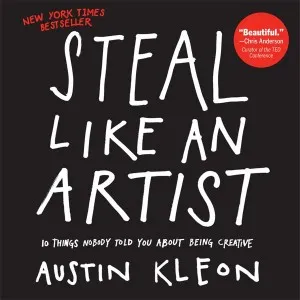[Book Review] Steal Like an Artist: 10 Things Nobody Told You About Being Creative
by Austin Kleon www.AustinKleon.com
2012 Workman Publishing, New York http://www.workman.com/authors/austin_kleon/
10 chapters; 160 pages
You don’t need to be a genius, you just need to be yourself. That’s the message in this new book by Austin Kleon, a young writer and artist based in Texas. Creativity is everywhere, creativity is for everyone – these points are driven home by this book packed with illustrations, exercises, and examples. The material will appeal to aspiring entrepreneurs, as well as potential innovators in larger organisations and creativity coaches.
See also my earlier reviews of the related books The Idea Hunter and Creativity Now, and my interviews with the authors Andy Boynton and Jurgen Wolff.

When Kleon was asked to address college students in upstate New York, he shaped his creativity speech around the ten things he wished someone had told him when he was starting out. The talk went viral, and the author dug deeper into his own ideas to create this book.Austin Kleon (Twitter: @AustinKleon) is the author of the poetry collection Newspaper Blackout, and his work has been featured on NPR’s Morning Edition, PBS NewsHour, The Wall Street Journal, and the art website, 20x200.com. He speaks about creativity and being an artist online for organisations such as SXSW, TEDx, and The Economist.
I have briefly summed up his ten-point formula below; the book itself makes for a quick and stimulating read.
1. Steal like an artist
The author cautions that he does not mean ‘steal’ as in plagiarise, skim or rip off -- but study, credit, remix, mash up and transform. Creative work builds on what came before, and thus nothing is completely original.
Artists collect the work of others, but selectively and not indiscriminately. Doing a deep dive into a range of your favourite artists will make you realise you can be part of a creative lineage.
“Always be reading. Go to the library. There’s magic in being surrounded by books. Collect books, even if you don’t plan on reading them right away. Nothing is more important than an unread library,” Kleon advises. Start with search, then research. Keep a scrap book or ‘swipe file’ to jot down notes about your observations.
2. Fake it till you make it
You have to start doing the work you want to be doing, you have to immerse, internalise and even dress like the person you aspire to be. “You don’t have to look like your heroes, you want to see like your heroes,” Kleon urges.
Go beyond imitation to emulation. After all, David Letterman tried to copy Johnny Carson but ended up as David Letterman; similar evolution can be observed in basketball stars such as Kobe Bryant. Interestingly, it is impossible to copy art perfectly, and that is how you end up unearthing your own individuality.
3. Write the book you want to read
It is important to do what you want to do, and insert your take on things of art. Fan fiction is a good example here – how would you really want to see the sequel of your favourite movie or music album?
4. Use your hands
Though the Internet and social media are terrific connectivity and collaboration tools, it is important to also step away from the screen and immerse in actual physical work. “Computers have robbed us of the feeling that we’re actually making things,” Kleon cautions.
Involve your full body, and not just your brains – physical activity kickstarts your brain into thinking and fully engages your senses. Using computers in the ideation stage may actually turn you into ‘edit mode’ even before the idea has been fully explored. Kleon has an ‘analog desk’ and ‘digital desk’ to work in the two separate modes.
5. Side projects and hobbies are important
The magic sometimes happens with side projects and not your main work. “Practice productive procrastination,” Kleon advises. Side projects really take off, so take time to be bored; do boring things like ironing so your mind keeps wandering.
Wander around, and get lost. Keep all your passions in life and do not discard them, so they can pollinate each other. Don’t worry about a grand unified vision for your work right now, you can connect the dots later.
Hobbies are important because they keep you happy. “A hobby is something that gives but doesn’t take,” Kleon says.
6. Share your work with people
Sharing your work and even your thoughts about what you like help you get good feedback and more ideas. The Internet can be a good incubator and accelerator for your ideas in this regard. Social sharing keeps you on your toes. If you are scared of being plagiarised, share only glimpses of your work.
7. Geography is no longer our master
“Travel makes the world look new, and when the world looks new, our brains work harder,” Kleon explains. The further you travel the more insights you can get; a range of good food also helps! But constraints can also act favourably – bad winters or summers can force you to be indoors and work on your projects.
8. Be nice
Stop fighting and channel your rage into a creative pursuit. Show appreciation for the good things you see around you; keep a praise file about yourself, and not just a rejection file.
9. Be boring
You can’t be creative all the time, so set a routine – for example, with a regular day job which sets a fixed schedule and exposes you to new people and skills.
Learn about money management. Get a wall calendar which shows you the full year ahead so that you get a good sense of perspective – and also keep a diary or logbook to record your achievements, ups and downs.
10. Creativity is subtraction
In an age of information overload and abundance, focus is important. Choose what you want to leave out of your key work. “Nothing is more paralysing than the idea of limitless possibilities. The best way to get over creative block is to simply place some constraints on yourself,” Kleon says.
A good example here is Dr Seuss, who wrote his bestselling book with only 50 different words. Saul Steinberg says a work of art represents a struggle against limitations. “Creativity isn’t just the things we choose to put in, it’s the things we choose to leave out,” advises Kleon.
In sum, this pocketbook (little bigger than a CD box) is packed with useful insights on creativity. Cited books include What It Is (Linda Barry), Rework (Jason Fried), and Flow (C. Mihaly).
“Collect ideas, remix and re-imagine to discover your own path,” is a good way to sum up the book. It would be fitting to end this review with some of the useful inspirational quotes in the book:
Art is theft. (Pablo Picasso)
The only art I’ll every study is the stuff that I can steal from. (David Bowie)
Start copying what you love. Copy copy copy copy. At the end of the copy you will find your self. (Yohji Yamamoto)
The work you do while you procrastinate is probably the work you should be doing for the rest of your life. (Jessica Hische)
You can’t connect the dots looking forward, you can only connect them looking backwards. (Steve Jobs)
Distance and difference are the secret tonic of creativity. (Jonah Lehrer)
There’s only one rule I know of: You’ve got to be kind. (Kurt Vonnegut)
Complain about the way other people make software by making software. (Andre Yorrez)
In the digital age, don’t forget to use your digits! (Lynda Barry)
Avoiding work is the way to focus the mind. (Maira Kalman)
[Follow YourStory's research director Madanmohan Rao on Twitter at http://twitter.com/MadanRao]






![[Book Review] Steal Like an Artist: 10 Things Nobody Told You About Being Creative](https://images.yourstory.com/cs/wordpress/2013/10/Steal.jpg?mode=crop&crop=faces&ar=2:1?width=3840&q=75)




